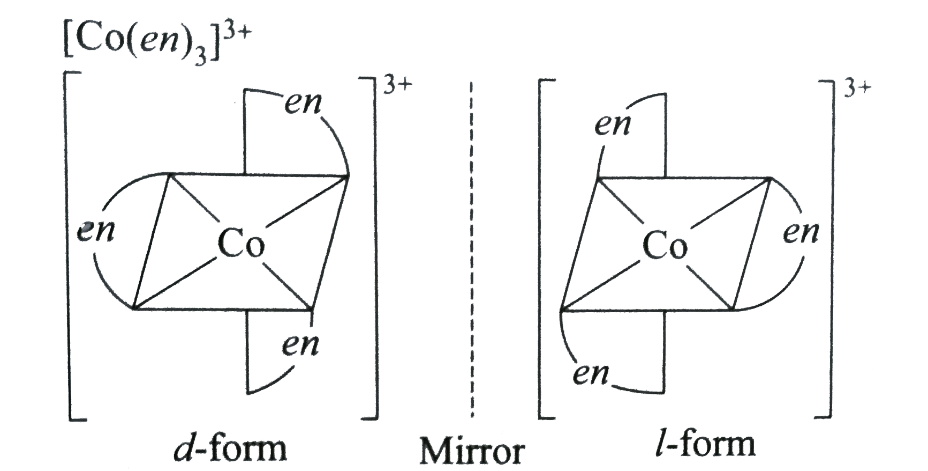Answer
394.5k+ views
Hint: Recall the types of isomerism given in the chapter Coordination compounds. Try to understand the types of isomerism given in the options with an example so as to check whether the compound given in question is that type of isomer or not. If the pair of complex compounds are not any type of isomers then there is no isomerism between the two compounds.
Complete step by step answer:
Chemical compounds that consist of an array of anions or neutral molecules that are bound to a central atom via coordinate covalent bonds are called coordination compounds. Coordination compounds are also referred to as coordination complexes.
The neutral molecules or ions that are bound to the central atom are referred to as ligands or complexing agents. They act as Lewis base and donate electron pairs to transition metal ions, thus a dative bond is formed between ligands and the transition metal ion. Hence these compounds are coordination complexes.
Linkage isomerism is the existence of coordination compounds that have the same composition but differ in their connectivity with the central metal atom. Example:
- Thiocyanate ($SC{{N}^{-}}$) and isothiocyanate ($NC{{S}^{-}}$),
- Selenocyanate ($SeC{{N}^{-}}$) and iso selenocyanate ($NCS{{e}^{-}}$).
Ionization isomers have the same composition and formula but give different ions upon dissociation. Example:
- \[[Co{{(N{{H}_{3}})}_{5}}Br]S{{O}_{4}}\]and \[[Co{{(N{{H}_{3}})}_{5}}S{{O}_{4}}]Br\]
Coordination isomerism is a form of structural isomerism in which the composition of complex ion is different in the pair of isomers. In a coordination isomer the total ratio of ligand to metal remains the same, but the ligands attached to a specific metal ion are different. Example:
- ${{[Zn{{(N{{H}_{3}})}_{4}}]}^{+2}}{{[CuC{{l}_{4}}]}^{-2}}$ and ${{[Cu{{(N{{H}_{3}})}_{4}}]}^{+2}}{{[ZnC{{l}_{4}}]}^{-2}}$.
From the above explanation we see that the given pair of complex compounds do not match with any of them examples mentioned. Hence there is no isomerism between the two complex compounds.
So, the correct answer is “Option D”.
Note: Like organic compounds, transition metal complexes show geometrical and optical isomers. For e.g. the below pair of complexes are in cis-trans form:

The complex ${{[Co{{(en)}_{3}}]}^{+3}}$ shows optical isomerism:

Complete step by step answer:
Chemical compounds that consist of an array of anions or neutral molecules that are bound to a central atom via coordinate covalent bonds are called coordination compounds. Coordination compounds are also referred to as coordination complexes.
The neutral molecules or ions that are bound to the central atom are referred to as ligands or complexing agents. They act as Lewis base and donate electron pairs to transition metal ions, thus a dative bond is formed between ligands and the transition metal ion. Hence these compounds are coordination complexes.
Linkage isomerism is the existence of coordination compounds that have the same composition but differ in their connectivity with the central metal atom. Example:
- Thiocyanate ($SC{{N}^{-}}$) and isothiocyanate ($NC{{S}^{-}}$),
- Selenocyanate ($SeC{{N}^{-}}$) and iso selenocyanate ($NCS{{e}^{-}}$).
Ionization isomers have the same composition and formula but give different ions upon dissociation. Example:
- \[[Co{{(N{{H}_{3}})}_{5}}Br]S{{O}_{4}}\]and \[[Co{{(N{{H}_{3}})}_{5}}S{{O}_{4}}]Br\]
Coordination isomerism is a form of structural isomerism in which the composition of complex ion is different in the pair of isomers. In a coordination isomer the total ratio of ligand to metal remains the same, but the ligands attached to a specific metal ion are different. Example:
- ${{[Zn{{(N{{H}_{3}})}_{4}}]}^{+2}}{{[CuC{{l}_{4}}]}^{-2}}$ and ${{[Cu{{(N{{H}_{3}})}_{4}}]}^{+2}}{{[ZnC{{l}_{4}}]}^{-2}}$.
From the above explanation we see that the given pair of complex compounds do not match with any of them examples mentioned. Hence there is no isomerism between the two complex compounds.
So, the correct answer is “Option D”.
Note: Like organic compounds, transition metal complexes show geometrical and optical isomers. For e.g. the below pair of complexes are in cis-trans form:

The complex ${{[Co{{(en)}_{3}}]}^{+3}}$ shows optical isomerism:

Recently Updated Pages
Basicity of sulphurous acid and sulphuric acid are

Three beakers labelled as A B and C each containing 25 mL of water were taken A small amount of NaOH anhydrous CuSO4 and NaCl were added to the beakers A B and C respectively It was observed that there was an increase in the temperature of the solutions contained in beakers A and B whereas in case of beaker C the temperature of the solution falls Which one of the following statements isarecorrect i In beakers A and B exothermic process has occurred ii In beakers A and B endothermic process has occurred iii In beaker C exothermic process has occurred iv In beaker C endothermic process has occurred

What is the stopping potential when the metal with class 12 physics JEE_Main

The momentum of a photon is 2 times 10 16gm cmsec Its class 12 physics JEE_Main

How do you arrange NH4 + BF3 H2O C2H2 in increasing class 11 chemistry CBSE

Is H mCT and q mCT the same thing If so which is more class 11 chemistry CBSE

Trending doubts
Difference Between Plant Cell and Animal Cell

Difference between Prokaryotic cell and Eukaryotic class 11 biology CBSE

Fill the blanks with the suitable prepositions 1 The class 9 english CBSE

Change the following sentences into negative and interrogative class 10 english CBSE

Summary of the poem Where the Mind is Without Fear class 8 english CBSE

Give 10 examples for herbs , shrubs , climbers , creepers

Write an application to the principal requesting five class 10 english CBSE

What organs are located on the left side of your body class 11 biology CBSE

What is the z value for a 90 95 and 99 percent confidence class 11 maths CBSE



